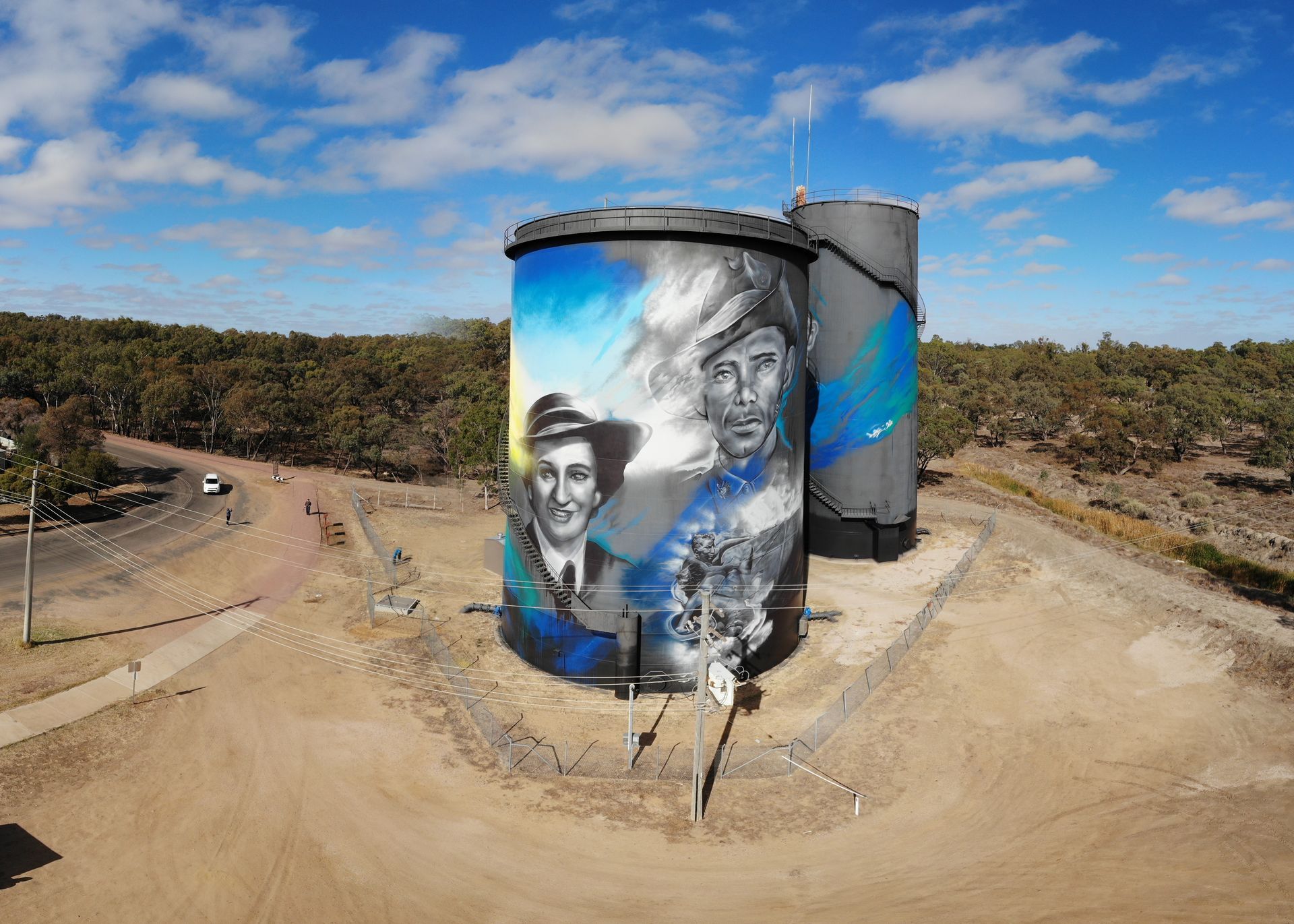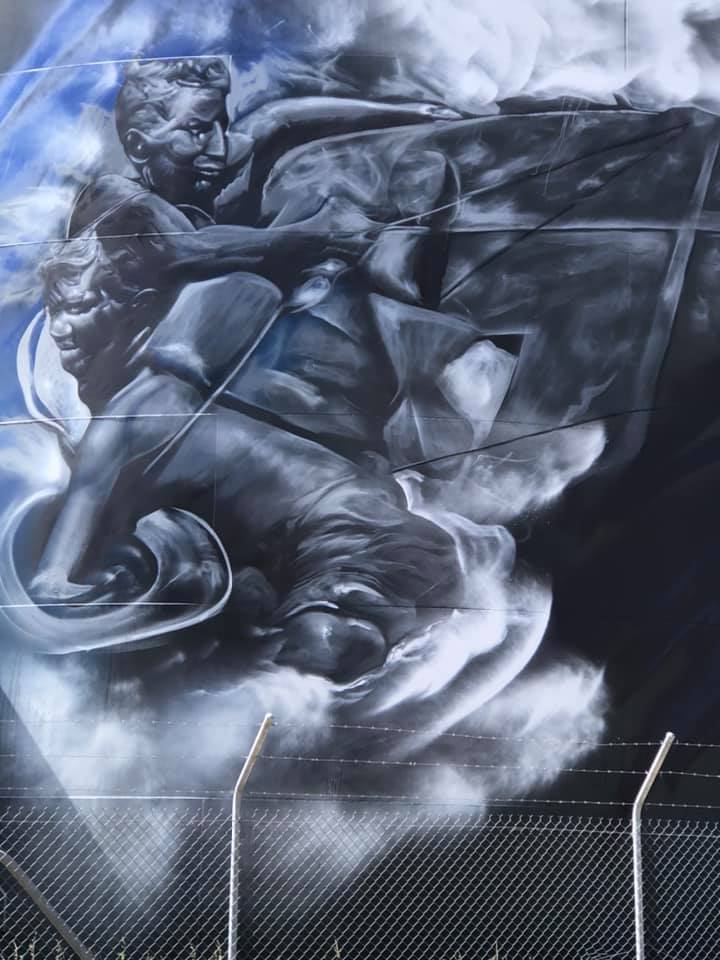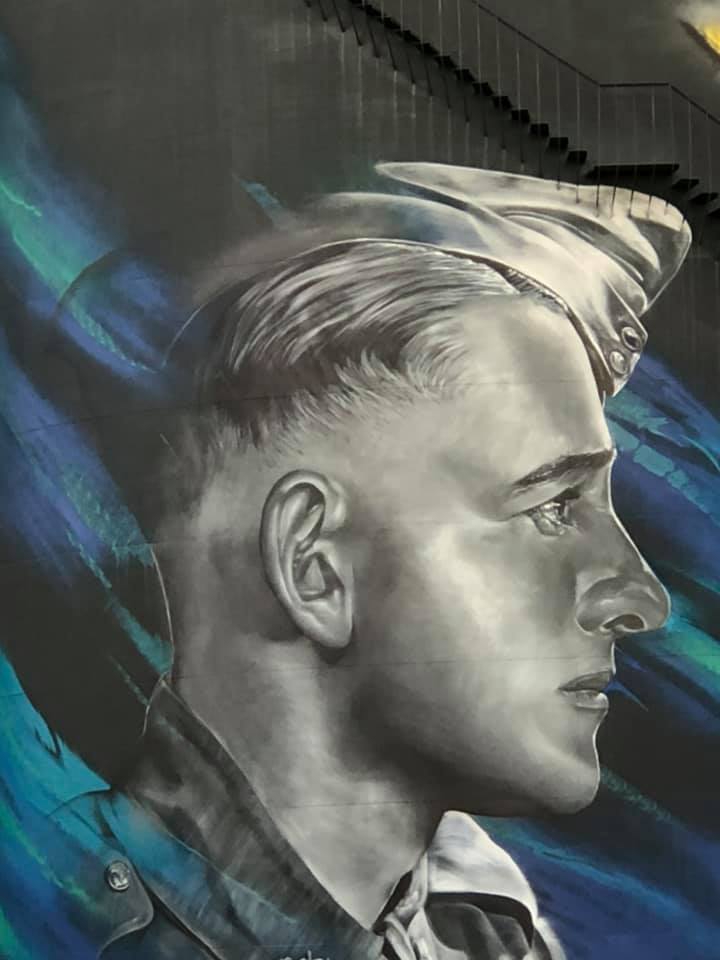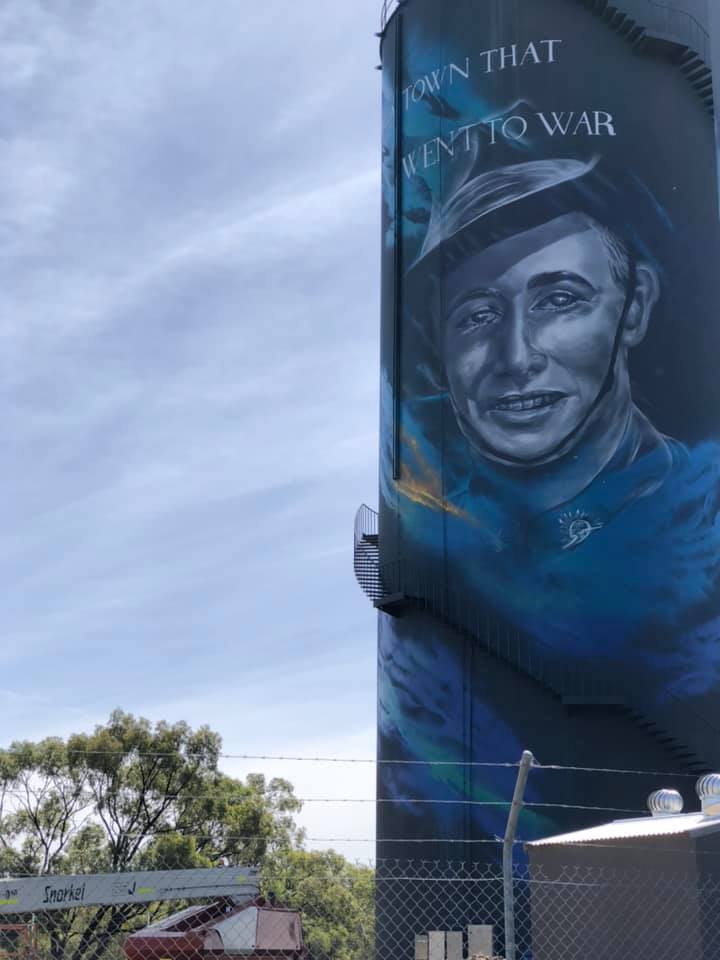
Photo by: Gary Grande
Hay Water Tower Art - New South Wales
Artists: Adnate & Bill Campbell
Location: 111 Pine Street, Hay, NSW
Video by: @ken-Keof
The Town That Went to War
Over just a few short days in December 2020 a magnificent tribute to the servicemen and women of Australia emerged on the Hay landscape. Using the towns Water Tanks as a backdrop, artists Matt Adante & Bill Campbell created a lasting memorial to the contribution of the people of Hay to the World Wars. The towers, located near the famous Sandy Point Beach, have already began to draw crowds eager to capture an image of the five faces that now stand sentinel over the town. The Water Tower Art is the latest edition to the Australian Silo Art Trail that has proved such an attraction for regional Australia.
Thank you to Alison McLean from the Hay Shire Council for the great information located on this page
Lieut. Lorna Margaret Whyte, AANS
Location: Northern Tower, northern side (only female)
Lorna Whyte was born in Hay 19th April 1915, the youngest of eight children. She attended the Hay War Memorial High School before training as a nurse at the Corowa Hospital in NSW.
In 1941 she joined the Australian Army Nursing Service (AANS) and was one of six nurses chosen to go to the island of New Britain. Rabaul was the peacetime capital of this Australian Mandated Territory of New Guinea, having been captured from the Germans in 1914. Sadly, a few weeks before embarkation, Lorna returned to Hay to nurse her father in an illness that proved fatal.
Travelling aboard the Wahini with the 2/22nd Battalion AIF, which formed the bulk of Lark Force, the women arrived at Rabaul on the 25th April 1941 to spend the year at the 2/10th Australian General Hospital treating soldiers suffering from tropical diseases.
Japanese Invasion of Australian Territory
Following the bombing of Rabaul on the 4th January 1942 and almost daily thereafter, the Japanese began their ground invasion of Australian territory on the 23rd January 1942.
To read more about Lorna to learn her full story click
here
Pte. Victor George Murray - 2/20th Battalion AIF, 8th Division
Location: Northern Tower, north west top image
Victor George Murray was born on the 29th July 1909 in Brewarrina, NSW and a member of the Ngemba tribal group. He married Bessie in 1929 and they lived on the Aboriginal Reserve in Condobolin, NSW. They had three children Beryl, Olive and George.
He was an extraordinarily talented young man, a clever mechanic, and designed an ingenious water system that reticulated water from a creek off the Lachlan River to his house on the reserve.
First Enlistment Australian Military Forces
Victor first enlisted in the Australian Military Forces at Condobolin on the 15th May 1940 and formally signed the Oath of Enlistment on the military attestation form at Paddington Sydney on the 29th May 1940. His experience as a mechanic gave him the opportunity to be drafted as a Sapper* into the Engineers 2/4th Field Company, 7th Division. He was given the Army Service No.NX18444.
*A Sapper is an engineer who is a fighting soldier in his own right. He performs a variety of military engineering duties such as building and repairing roads and bridges, clearing mines, preparing field defences and breaching enemy fortifications.
On the 29.7.40, Victor was posted to the position of a specialist engine hand with Group III at the Ingleburn army camp NSW.
To read more about George and to learn his full story here
Cpl. Clifford Leslie Farlow – 2/19th Battalion AIF, 8th Division
Northern Tower, north west image at bottom (in battle scene)
Cliff Farlow was born on the 27th April 1922 and moved to Hay as a baby with his parents when they took up a block, Rosedale, on the Hay Irrigation Area to run a successful dairy. He attended the Hay Public and War Memorial High Schools.
He voluntarily enlisted in the Australian Imperial Force on the 26th June 1940 at Wagga Wagga NSW, aged 18 years. He trained at Walgrove, Ingleburn and Bathurst NSW army camps before leaving Sydney for overseas service on the passenger liner RMS Queen Mary on the 4th February 1941. The Queen Mary had since been modified for the transport of troops and given the capacity of 16,000 men. She was fitted with small calibre guns but her greatest defence against enemy U-boats was her incredible speed.
Destination Unknown
After leaving Freemantle, the Queen Mary split from the main convoy in the Indian Ocean and sailed full steam for Singapore under the protective escort of a single warship. She docked in Singapore harbour on the 18th February 1941. Not long after Cliff’s embarkation, his unit boarded a northbound train for Seremban, Malaya, his first camp overseas.
Pte. William ‘George’ Cannon, 2/1st Battalion and 2/1st Field Regiment, 6th Division AIF
Location: Northern Tower, Eastern Side.
George Cannon was born on the 3rd March 1919 and grew up in Booligal. He was the only child of William Patrick Cannon, a returned Light Horseman who served in Palestine during the Great War. George’s mother was Isabelle Melrose from Hay and lived on local properties Gre Gre and Eli Elwah as a child.
George’s early education was by home tutoring at Booligal before leaving for boarding school in Sydney from 1929 – 1936. After leaving school he jackerooed in the Jerilderie district of NSW. After some years there he travelled north to Queensland shortly before the outbreak of the Second World War.
Enlistment Second World War
Like 300 other young men from Hay, George answered the early call in 1939 after travelling with a mate virtually non-stop from Dirranbandi, Qld to enlist in Sydney.
George was drafted into the 2/1st Battalion AIF, 6th Division.
The 2/1st Battalion was raised at Victoria Barracks, Sydney on the 16th October 1939 to become ‘The City of Sydney’s Own Regiment’. It was part of the 16th Brigade of the 6th Australian Division AIF and relocated to the newly opened Ingleburn Camp on 2nd November 1939.
To read more about George and to learn his full story
here
Pte. Norman Charles Flack – 2/19th Battalion, 8th Division
Location: Southern Tower (under writing)
Norman Charles FLACK was born in Hay, NSW on 2nd January 1920. He was a popular and highly thought of young man, regularly attending and participating in the service of the Anglican Church. Norman was a keen tennis player and became a very good bike rider and placed in many road races. He completed a 5 year apprenticeship as a motor mechanic with Hay Motors and remained employed with them on his return from the war.
Norman enlisted in the Australian Army on 26th June 1940 at Wagga Wagga, serving in the Ordnance Corp, 2/19th Battalion, 8th Division which consisted largely of bushman recruits from the country, particularly the Riverina area of NSW. His unit trained in camps at Wagga Wagga, Wallgrove, Bathurst and Liverpool.
Unknown Destination - WWII
On the 4th February 1941, Norman’s battalion embarked from Sydney in convoy aboard the great liner, the Queen Mary (QM). For security reasons their destination was unknown to them. Somewhere in the Indian Ocean the QM broke away from the main Middle East convoy, and now unrestricted by slower vessels, sailed full steam for Singapore under the protective escort of a single warship. She docked in Singapore harbour on the 18th February 1941.
Read more about Norman and learn his full story here






